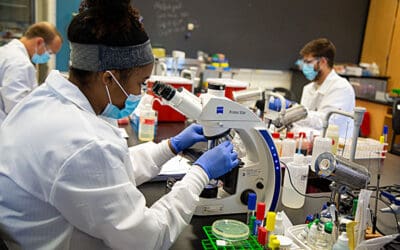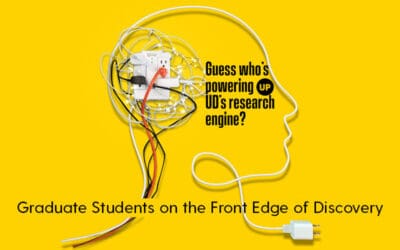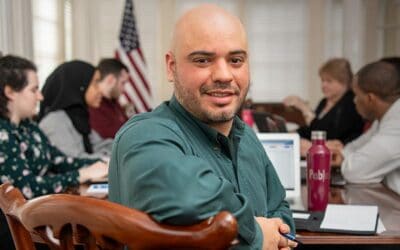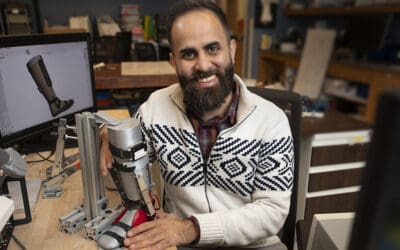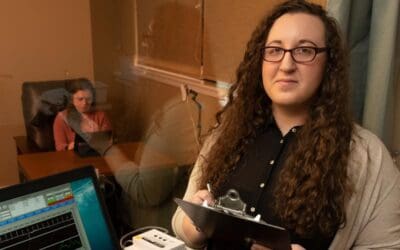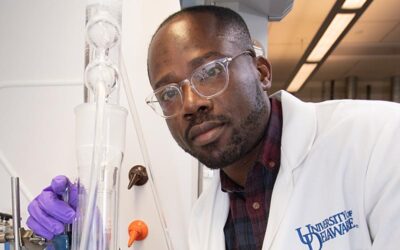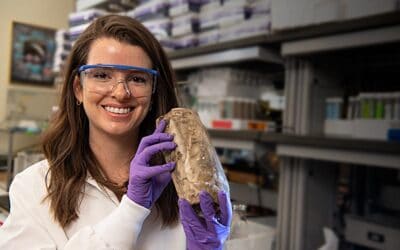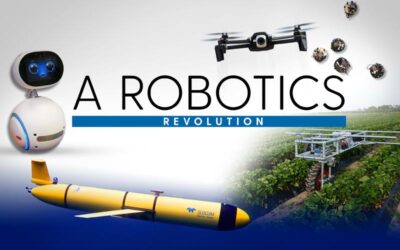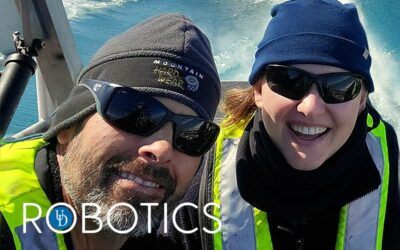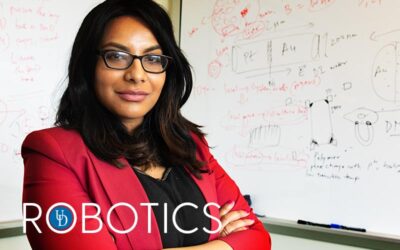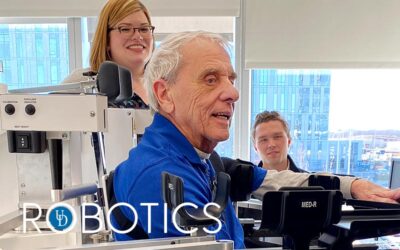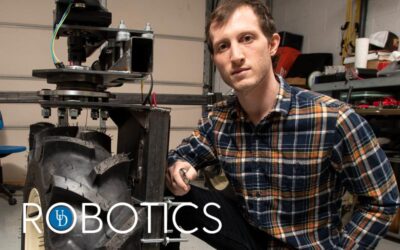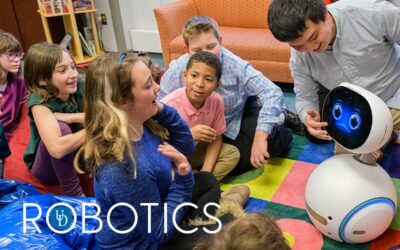UD ROBOTICS
A buzz is in the air
Panos Artemiadis has been working on “brain-swarm” research that allows humans to control the collective behavior of robotic devices with brainpower alone. This is of keen interest to anyone whose work would benefit from a group of drones, for example, teams doing search and rescue or environmental monitoring.
Robots these days!
by Beth Miller
They’re climbing walls, conducting orchestras, practicing yoga, doing standup comedy, even pulling rickshaws.
They’re a busy, versatile lot and their range seems to increase every hour.
But for Panagiotis “Panos” Artemiadis, associate professor of mechanical engineering at the University of Delaware and director of its graduate program in robotics, the work of robotics has one purpose: Make life and work better for their human creators.
“Everything I do should have that human component,” he said.
And it does. Artemiadis’ work is on the front edge of robotics research as he and his students develop devices that interact with and collaborate with humans in physical and cognitive ways.

ABOVE: Panos Artemiadis and students in his Human-Oriented Robotics and Control Lab are working to develop and control swarms of robots that interact with humans. Photo by Evan Krape

ABOUT PANOS
Panos Artemiadis came to UD’s faculty by way of Athens, Greece, MIT and Arizona State. He sees UD — with its top-ranked Department of Physical Therapy and strong Department of Biomedical Engineering — as a superb place to extend the impact of his Human-Oriented Robotics and Control (HORC) Lab, a practical proving ground for devices that could produce real advances for patients and clinicians. He hopes to start recruiting patients later this year.
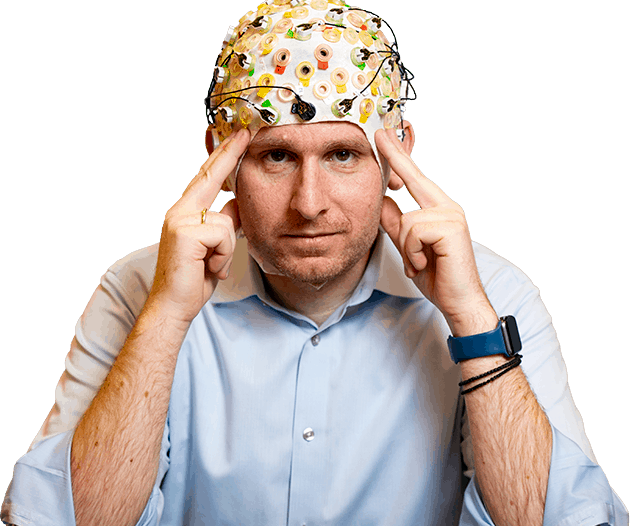





He was on the organizing committee for two workshops at the 2020 International Conference on Robotics and Automation in Paris in late May. One was on human-swarm interaction and the other was on dynamic lower-limb prostheses.
Artemiadis has been working on “brain-swarm” research that allows humans to control the collective behavior of robotic devices with brainpower alone. This is of keen interest to anyone whose work would benefit from a group of drones, for example, teams doing search and rescue or environmental monitoring.
He also has been working on active robotic prostheses. One of his projects now is developing and testing a prosthetic ankle-foot device that flexes and adjusts to varying terrain, such as sand or grass, as the human ankle does naturally. That requires a deep understanding of how the ankle works and how the brain perceives the environment, makes decisions in milliseconds and controls muscle motion.
“I want to learn how humans do it so I can make better robots,” he said. “My goal is to be sure we use that technology and these control methods for improving the quality of life and work.”
To train machines to work effectively with humans and their muscles, he studies brain activity, electrical activity in muscles and all sorts of biomechanics. The goal is to decode all of that information in ways that are meaningful to robotic devices so that the motion they enable is smooth and coordinated.
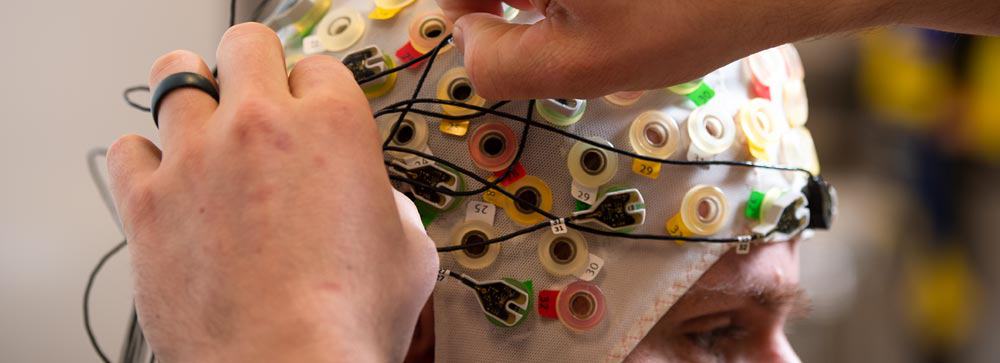
ABOVE: A special head cap, fitted with electrodes, uses electroencephalographic (EEG) brain activity to control robots. Pre-pandemic photo by Evan Krape
For example, a “brain cap” — a sensor-laden device that looks like a shower cap, except that it has dozens of wires coming out of it – uses only the electrical signals from the brain to control the robotics it communicates with.
Devices with that kind of savvy also will make useful contributions to other tools — both therapeutic and assistive — such as exoskeletons, orthotics and rehabilitative robots.
In addition to these projects, Artemiadis is working to understand the rehabilitative needs of stroke patients to develop devices and methods that can help them with their recovery efforts.
“Robot-assisted stroke rehabilitation has direct impact,” he said. “That first month after a stroke is very important.”
These are significant endeavors that have yet to be tested by those who would benefit most from them — patients.
And that is exactly why Artemiadis came to join UD’s faculty — by way of Athens, Greece, MIT and Arizona State. He sees UD — with its top-ranked Department of Physical Therapy and strong Department of Biomedical Engineering — as a superb place to extend the impact of his Human-Oriented Robotics and Control (HORC) Lab, a practical proving ground for devices that could produce real advances for patients and clinicians. He hopes to start recruiting patients later this year.
Artemiadis, whose twin brother, Artemios, is a neurologist in Greece, arrived at UD in August 2019 and is still developing his UD work space. He has an area in Spencer Lab, where his robot teams — aerial quadrotors and ground-based robots — are standing by. He and his students teach them how to work together, cooperating to overcome obstacles, for example, without further human involvement. He had a 10,000-square-foot arena for that work while he was at Arizona State. At UD’s STAR Campus, he shares space with Prof. Jill Higginson, an expert in neuromuscular biomechanics who often collaborates with investigators who use rehabilitation robotics.
His work is of interest to NASA and the Department of Defense and much of it has potential application for agriculture and other industries. He has drawn extensive support from the National Science Foundation, and as he moves into clinical research with patients, he believes the National Institutes of Health will find much of interest, too.
“We have the devices and the methods and we have had time to test them,” he said. “Now we want to make the next step.”
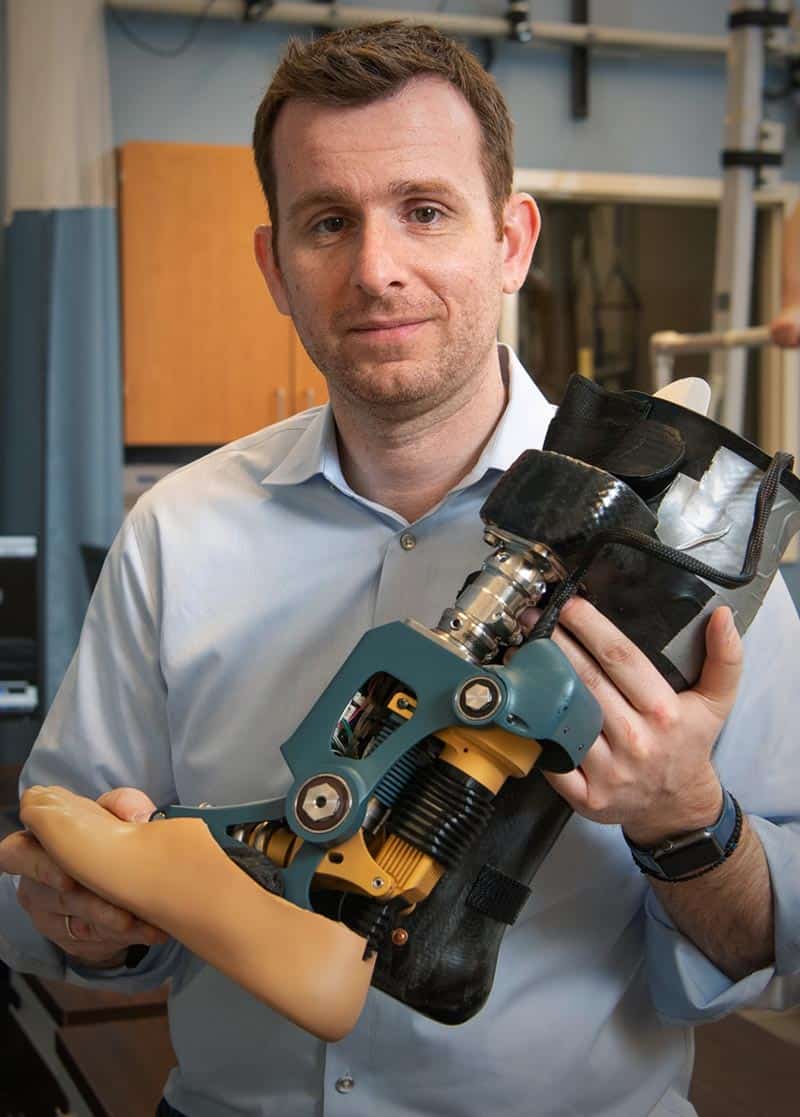
“I want to learn how humans do it, so I can make better robots. My goal is to be sure we use that technology and these control methods for improving the quality of life and work.”
—PANOS ARTEMIADIS
A UD Robotics Revolution
This special section of our digital magazine highlights an autonomous revolution taking place at UD.
MORE STORIES
From the Vice President for Research, Scholarship and Innovation: Moving Forward
The UD research community continues to navigate COVID-19, with health and safety the highest priority. In spite of hardships, we’re facing the pandemic with vigilance and resilience.
News Briefs
Check out our COVID-19 research, a virtual visit with the editor-in-chief of Science, and undergrads at work on the Frontiers of Discovery.
Honors: Celebrating Excellence
UD faculty and students have won major recognition for their expertise and contributions.
Guess Who’s Powering Up UD’s Research Engine?
This issue of the University of Delaware Research magazine introduces you to a critical creative force at UD — our graduate students and postdoctoral researchers. Their ingenuity is lighting new routes to discovery and solutions.
Front Edge of Discovery: Strengthening democracy for a better world
It all began with a Joseph Conrad novel. Doctoral student Pablo McConnie-Saad discusses his journey to better understand democracy, as the first Whittington Graduate Fellow at the Biden Institute.
Front Edge of Discovery: Developing resilient Black girls
Doctoral student and Graduate Scholar Nefetaria Yates is examining school discipline and the tactics Black girls have developed for dealing with the pressures they face. Her ultimate goal is to elevate voices that have been silenced.
Front Edge of Discovery: Helping children move
Entrepreneur Ahad Behboodi wants to see kids with cerebral palsy move more freely. He plans to commercialize a robotic foot device with the power to help them.
Front Edge of Discovery: A clinical science approach
Lexie Tabachnick, in her fifth year of doctoral studies, helps to mentor other grad students and undergraduates while she studies the powerful impact a UD-developed family intervention program is having on vulnerable kids.
Front Edge of Discovery: Beyond the hands of a potter
Sanchita Balachandran, associate director of Johns Hopkins Archaeological Museum and doctoral student in preservation studies at UD, is uncovering the forgotten makers of ancient Greek ceramics, and in so doing, changing our understanding of the past.
Front Edge of Discovery: Changing the world, one food waste at a time
Elvis Ebikade thinks potato peels hold a lot of promise. He’s working on converting the food waste to valuable chemicals and fuels that can power an environmentally-friendly future.
Front Edge of Discovery: The thing about permafrost is…
As a postdoctoral researcher, Liz Coward collected samples of permafrost from the icy walls of a research tunnel in Alaska to study the carbon stored within it.
A Robotics Revolution
Researchers at the University of Delaware are leveraging robotic systems to gain traction on tough problems. Learn how they are driving forward transformative solutions in agriculture, precision medicine, health care, cybersecurity, marine ecology and more.
UD Robotics: Antarctic food webs
University of Delaware researchers Matthew Oliver and Katherine Hudson think that some biological hotspots in Antarctica may operate less like local farms and more like grocery stores. If they are correct, it could provide new information about how this ecosystem will be affected under climate change.
UD Robotics: Meet me on the cutting edge
Sambeeta Das is forging into an exciting world you can see only with high-powered microscopes, where sci-fi meets reality. Welcome to the world of microrobots!
UD Robotics: Allies in Overcoming Stroke
Stroke is a leading cause of long-term disability, but UD Professor Jennifer Semrau is working to change that. With the help of a robot, she’s uncovering a critical sixth sense that gets sidelined with stroke.
UD Robotics: Startup with Roots
Adam Stager is working on chemical-free ways to help strawberry farmers improve yield using an autonomous field robot.
UD Robotics: Social Robots
Children have grown up with interactive technologies like Siri, Google and Alexa, but they don’t always know how to stay safe online. UD researchers are working on ways to help them.
A Jewish Oral History
A class helps preserve the precious stories of a little-documented time in Jewish life.
Test Your Knowledge: Getting Back to Nature
To reduce stress and strengthen our immune systems, experts often point us to the outdoors. So let’s get moving! There’s lots to see and hear, absorb and appreciate in nature.


